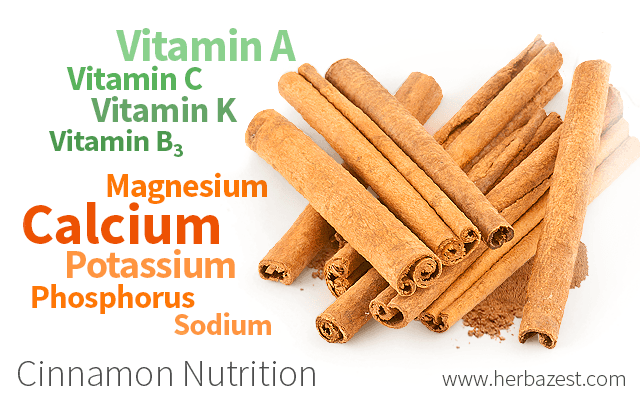Being a popular culinary spice, the nutritional value of cinnamon is often overlooked. The different varieties and types of cinnamon can slightly vary in nutritional composition. The two main types of the spice, Ceylon, or real cinnamon (Cinnamomum verum) and cassia, or Chinese cinnamon (Cinnamomum cassia), have varying levels of some nutrients possibly because of their different origins. Learn more about the many nutrients in cinnamon and the benefits they hold.
Nutritional Value of Cinnamon
Cinnamon contributes to human health with small amounts of some essential nutrients, such as proteins, carbohydrates, and fatty acids.
Proteins
One of the most unexpected cinnamon's nutritional benefits is the high level of protein in its bark. Ceylon cinnamon has 9.45 g of protein per 100 g, which is almost twice as much as cassia (3.99 g/100 g).1 Protein is a vital macronutrient that helps the body build tissue, bones, muscles, cartilage, skin, and blood. Many of the proteins found in both types of cinnamon are made of essential amino acids that they body cannot make on its own.
Carbohydrates
Carbohydrates are another main component of cinnamon nutrition that are responsible for providing energy. The carbohydrate level in true cinnamon is 55.83 g/100 g, which is slightly more than the amount in the Chinese variety (47.25 g/100 g). The body transforms all carbohydrates into glucose, which is used to produce energy. It is important to monitor one's carbohydrate intake, even calories in cinnamon, because consuming more than the recommended daily allowance for adults (300 g) can lead to weight gain, if it is not burned through physical activity.
Fatty acids
The bark of the cinnamon tree contains a small amount of fatty acids; 4.69 g/100 g in Ceylon and 4.65 g/100 g in cassia. These fatty acids are believed to contribute to the benefits of cinnamon for skin health and are also helpful in stimulating good eyesight and brain development in babies and children.
While cinnamon is especially high in palmitic acid, a type of saturated fat that is thought to contribute to raising bad cholesterol levels, a small amount of unsaturated fat is also found in its bark in the form of oleic acid. In order to balance out fat intake, cinnamon should be consumed along with other food ingredients containing high levels of unsaturated fats.
Supporting Nutrients in Cinnamon
Both types of cinnamon contain insoluble fiber; however, Chinese cinnamon carries 33.41 g/100 g, a significantly higher amount compared to the Ceylon variety, which offers 21.27 g per 100 g. The importance of the fiber in cinnamon nutrition is related to its many health benefits. Insoluble fiber cannot be absorbed by the body, so its helps digestion by regulating blood sugar levels after meals and also relieves constipation. Slower digestion encourages satiety, which helps with weight control. The fiber and calcium in cinnamon have been found to help protect the body against heart diseases by reducing cholesterol levels.
Cinnamon's nutritional benefits are significantly affected by the various compounds found in the spice. Essential oils are key nutrients in cinnamon and make up to 4% of cinnamon content, chiefly cinnamaldehyde (60-75%). They not only provide flavor and have major medicinal uses, but are also responsible of cinnamon antifungal and antibacterial activity.
On the other hand, cinnamon oil contains eugenol (1-10%), which has demonstrated anti-inflammatory properties. One of the reasons why Ceylon is considered the best cinnamon lays in its higher oil content. Common medicinal uses of the spice include cinnamon remedies for osteoarthritis, rheumatism, toothaches, and sore gums.
The presence of alkaloids in cinnamon is believed to be responsible for its success in eliminating nematodes and parasitic worms, according to a study published in the International Research Journal of Pharmacy (2013). Moreover, the cinnamaldehyde in the spice has been shown to have a neuroprotective action against Parkinson's disease.
Cinnamon Nutrition Facts
Cinnamon nutrition goes beyond the previously mentioned compounds in the spice. Here are a few helpful cinnamon nutrition facts:
Cinnamon provides choline, an essential nutrient that plays a key role in human metabolic processes, from cell structure to fat metabolism and neurotransmitter synthesis.
The nutritional content of cinnamon includes small amounts of vitamins A, C, K, and B3 (niacin), which contribute to a balanced diet.
Cinnamon is rich in calcium (690-1157 mg /100 g), followed by potassium, magnesium, phosphorus, and sodium.
Popularly known as a flavoring agent and a medicinal spice, it may come as a surprise to know that the nutritional value of cinnamon can help complement a balanced diet with the addition of essential compounds that greatly contribute to human health.
Sources
- Critical Reviews in Food Science and Nutrition, Chemistry, biogenesis, and biological activities of Cinnamon zeylanicum, 2011
- Handbook of Herbs and Spices, p. 182-191
- National Institutes of Health, National Center for Complementary and Integrative health - Cinnamon
- Penn State University, Penn State Dining Dietitians, Spilling the Facts About Cinnamon
Footnotes:
- USDA. FoodData Central. (2019). Spices, cinnamon, ground (Cinnamon cassia). Retrieved October 25, 2021, from: https://fdc.nal.usda.gov/fdc-app.html#/food-details/171320/nutrients




